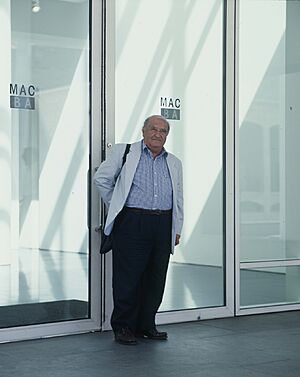Raymond Hains facts for kids
Quick facts for kids
Raymond Hains
|
|
|---|---|

Raymond Hains, Barcelona, 1999
|
|
| Born | 9 November 1926 Saint-Brieuc, France
|
| Died | 28 October 2005 Paris, France
|
| Nationality | French |
| Known for | Décollage, mixed media |
| Movement | Nouveau réalisme |
Raymond Hains (born November 9, 1926 – died October 28, 2005) was an important French visual artist. He helped start the Nouveau réalisme (New Realism) art movement. In 1960, he signed a special paper called the Manifesto of New Realism. Other artists like Arman, François Dufrêne, and Yves Klein also signed it.
In 1976, Raymond Hains had his first big art show in Paris. He called it La Chasse au C.N.A.C. (Hunt at the C.N.A.C.). Later, in 1997, he won the Kurt Schwitters Prize for his art. His work was also shown at the famous 57th Venice Biennale in 2017. The Centre Georges Pompidou in Paris held a large show of his art in 2001, called La tentative (The Endeavour).
Contents
Early Life and Art Training
Raymond Hains was born on November 9, 1926, in Saint-Brieuc, France. He went to art school at the École des Beaux-Arts in Rennes. He studied sculpture there for about six months.
After that, he decided to move to Paris. While at school, he met another artist named Jacques de la Villeglé. They later worked together on many art projects.
Raymond Hains' Art Career
Photography and New Ideas
After leaving art school, Hains moved to Paris. He started learning photography with a photographer named Emmanuel Sougez. In 1946, he began making his first special photos. These included `photograms` (pictures made without a camera) and `solarizations` (photos with reversed tones).
He later met André Breton, a famous artist, and showed him his work. Hains made abstract photos using a round reflector with small mirrors. This made his subjects look broken up and multiplied. For one of his first works, he photographed an old Etruscan object through broken glass. He called it Trésor de Golcondo (Treasures of Golcondo).
One day, Hains saw some broken glass in his family's workshop. It had paint splashes and acted like a prism. He decided to use this glass for his photos. He even invented a new kind of camera called the Hypnagogoscope. This name means "leading to sleep" or "dream-like." Hains used this to make his photos look abstract and dream-like, instead of just showing reality.
In 1948, he had his first photo show in Paris. It was called Hypnagogical Photographs. In 1952, he wrote about his ideas in a magazine. He explained that changing images made them abstract. He believed artists should invent new realities, not just copy what they see.
Films and Ultra-Letters
In 1949, Hains made his first short film. From 1950 to 1954, he made several more movies. He often worked with Jacques Villeglé on these films. They used special grooved glass on their cameras to make abstract, distorted films. These films were inspired by the cut-out art of Henri Matisse.
Hains also liked the work of the `Lettrist` artists. These artists focused on letters and words in their art. In 1950, Hains started making art that showed the `Lettrist` movement. He would shred letters using his special fluted lens. This made the letters look deformed and abstract.
In 1953, Hains and Villeglé published Hépérile éclaté. This was a special kind of poem that wasn't meant to be read normally. It was an Ultra-Lettrist presentation, where the words were visually "exploded."
Décollage Art
In 1949, Raymond Hains and Jacques Villeglé started making art from torn posters. They would take old concert posters and advertisements from city walls. This process is called `décollage`. It's like the opposite of collage, where you add things. With `décollage`, you remove or tear away layers.
Their first `décollage` artwork was called Ach Alma Manetro. They named it after words they saw in the torn posters. In 1954, Hains met Yves Klein, another famous artist. Later, in 1956, he met art critic Pierre Restany. In 1957, Hains and Villeglé had their first show of torn poster art in Paris.
SEITA and SAFFA Artworks
Starting in 1964, Hains began to create art under two made-up artist names: SEITA and SAFFA. These were the names of French and Italian companies that made tobacco and matches. He showed a giant matchbox at a gallery in Venice.
SAFFA made copies of matchboxes from the Italian company SAFFA. His French partner, SEITA, only copied French matchboxes. The next year, Hains had a show called Seita and Saffa: copyright by Raymond Hains. He acted as the agent for these two "artists."
Also in 1964, Hains showed Biennale déchirée (Torn Biennial) at the Venice Biennale. Four years later, he showed Biennale éclatée (Shattered Biennial). For this, he used his special fluted glass to distort the covers of the art show catalogs.
Computer Art and Pavement Sculptures
In 1997, Hains started making his first Macintoshages. This name came from words like "machine" and "Macintosh" (a type of computer). Macintoshages mixed computer texts and images. He would change them around on the screen.
He used computer tools to paste and unpaste texts and images. It was like how your mind works when you dream. At the same time, Hains also started making Pavement Sculptures. He would walk around streets with his camera. He took pictures of details at construction sites. For example, he might photograph a concrete block that looked like a sculpture to him.

